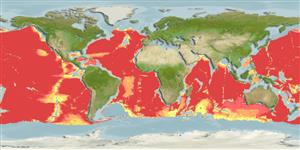>
Ophidiiformes (Cusk eels) >
Ophidiidae (Cusk-eels) > Neobythitinae
Etymology: Abyssobrotula: Greek, abyssos, deep, depth + Latin, brotula = little bud, shoot (Ref. 45335).
More on author: Nielsen.
Environment: milieu / climate zone / depth range / distribution range
Ecologia
marinhas batipelágico; intervalo de profundidade 3110 - 7965 m (Ref. 130003). Deep-water; 60°N - 60°S, 180°E - 180°E
In deep waters of tropical and subtropical areas of all oceans. 3 specimens from the Gulf of Guinea (Ref. 3686).
Tamanho / Peso / Idade
Maturity: Lm ? range ? - ? cm
Max length : 16.5 cm SL macho/indeterminado; (Ref. 3686)
Descrição suscinta
Morfologia | Morfometria
Head short with downward inflection. Snout swollen. Eyes small. Poorly developed opercular spine. Anterior gill arch with 8-11 developed gill rakers. Precaudal vertebrae 18-21.
The previous maximum depth reported was 8730 m, supposedy the deepest fish caught. However there was a mistake in the logbook of the station, the correct depht is now 7965 m, the third deepes fish 9as of Novemeber 2023 (Ref. 130003). Uncommon species (Ref. 34024). Reproductive strategy possibly similar to other members of this family being oviparous, with oval pelagic eggs floating in a gelatinous mass (Ref. 205).
Ciclo de vida ou comportamento de acasalamento
Maturidade | Reprodução | Desova | Ovos | Fecundidade | Larvas
Nielsen, J.G., 1990. Ophidiidae. p. 564-573. In J.C. Quero, J.C. Hureau, C. Karrer, A. Post and L. Saldanha (eds.) Check-list of the fishes of the eastern tropical Atlantic (CLOFETA). JNICT, Lisbon; SEI, Paris; and UNESCO, Paris. Vol. 2. (Ref. 3686)
Status na Lista Vermelha da UICN (Ref. 130435)
Ameaça para os humanos
Harmless
Uso pelos humanos
Pescarias: sem interesse
Mais informação
Nomes comunsSinônimosMetabolismoPredadoresEcotoxicologiaReproduçãoMaturidadeDesovaAgregação de desovaFecundidadeOvosDesenvolvimento dos ovos
Idade/TamanhoCrescimentoPeso-comprimentoComprimento-comprimentoFrequências de comprimentoMorfometriaMorfologiaLarvasDinâmica larvalRecrutamentoAbundânciaBRUVS
ColaboradoresFotosStamps, Coins Misc.SonsCiguateraVelocidadeTipo de nataçãoÁrea branquialOtólitosCérebrosVisão
Ferramentas
Relatórios especiais
Baixar XML
Fontes da internet
Estimates based on models
Preferred temperature (Ref.
123201): 0.7 - 2.4, mean 1.4 °C (based on 34031 cells).
Índice de diversidade filogenética (Ref.
82804): PD
50 = 1.0000 [Uniqueness, from 0.5 = low to 2.0 = high].
Bayesian length-weight: a=0.00380 (0.00165 - 0.00876), b=3.14 (2.93 - 3.35), in cm total length, based on LWR estimates for this (Sub)family-body shape (Ref.
93245).
Nível Trófico (Ref.
69278): 3.5 ±0.6 se; based on size and trophs of closest relatives
Resiliência (Ref.
120179): médio(a), tempo mínimo de duplicação da população 1,4 - 4,4 anos (Assuming tmax>3).
Fishing Vulnerability (Ref.
59153): Low vulnerability (10 of 100).
